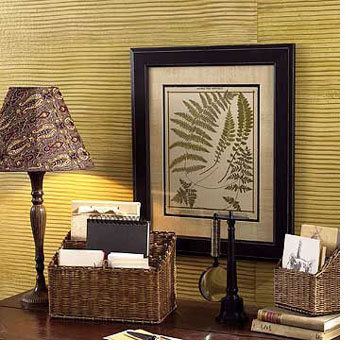Faux bamboo paint technique
Grass cloth are a popular way to evoke the faraway cultures as well as the rich texture of natural grasses.
A painted grass cloth finish can be a stylish substitute for expensive wall coverings without the fraying and easy soiling. By painting instead of wallpapering you can vary the colours to suit your decor. Grass cloth adds interest to a wide variety of settings. It is a natural choice for plantation- and Asian-theme rooms, but also works in transitional and relaxed modern decor.
YOU WILL NEED:
Masking tape
Drop cloth
Stirring sticks
Paint tray and roller
Paints: antique-white satin-finish paint for base coat;
warm-olive, greenish-gray, and mossy-brown satin-finish paints for glaze coat
Squeegee
Ruler
Fine-tip marker and pencil
Crafts knife and cutting mat
Metal yardstick
[3] plastic containers
Scumble glaze
Brush
Lint-free cotton cloths
HERE'S HOW:
1. Mask ceiling, baseboards, and trim with masking tape. Paint the entire wall in the antique-white base coat colour. Paint two coats if necessary. Leave tape on; let dry overnight.
2. Use a ruler and fine-tip marker to divide the blade of the squeegee into 2cm sections. Cut out a small notch, approximately 2mm, at every mark with a crafts knife; use a safe cutting surface, such as a self-healing cutting mat.
3. Using a metal yardstick and pencil, mark the wall in 1 metre- wide sections. Tape off alternating vertical sections with masking tape. In a plastic container, mix 4 parts glaze to 1 part warm-olive paint. Use the same process to make two additional glazes with greenish-gray paint and mossy-brown paint.
4. Dip the brush into varying combinations of glaze mixes. Starting at the top of the wall, brush glaze onto the first taped-off section using a horizontal motion.
5. While the glaze is still wet, place the squeegee on top of one taped edge and drag horizontally until you reach the opposite edge, pulling the squeegee onto the tape. Wipe excess glaze onto a cloth after each pass. Overlap the squeegee pulls to create a continuous pattern.
6. Using the brush, lightly dry-brush the lines in a horizontal motion to blend and soften.
7. Move down the wall, brushing on glaze with the brush. Overlap your brush strokes into the previously glazed section to create a continuous pattern.
8. Drag the squeegee horizontally through the glaze in the same manner as in Step 3. If glaze becomes too dry to produce continuous lines, add a small amount of water to your mixtures and reapply the glaze with a brush. This will dampen the surface and allow a clean sweep with the squeegee.
9. Lightly soften the lines with the brush, using a horizontal motion before the glaze dries. Continue until you've finished the section; let dry.
10. Tape off remaining sections. Repeat the process until the wall is completed. Remove remaining tape; allow to dry.
Design Tips:
Divide the wall into panels by taping off 1 metre-wide sections. To create the effect, dip your brush into varying combinations of glazes and apply to the wall. Drag a notched squeegee horizontally across the wet glazed surface, overlapping strokes to create a continuous pattern. Blend the lines with a brush to create a soft effect.

